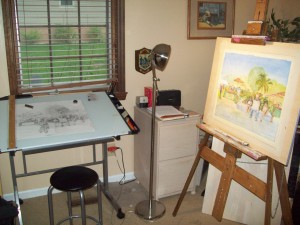
It would be great if all of us could afford the perfect artist’s studio filled with expensive furnishings, and have the luxury or means to create the ideal work area. However, where ever an artist sets up an easel is that artist’s studio for the moment. The important goal is that no matter where you decide to paint, it must be conducive to your creativity. You have to have a place spacious enough for your easel and paints and other needed paraphernalia where you can work, see, and think
The main reason I began painting with watercolor is that the medium does not require a large work area. At the time, I barely had more than a large closet from which to work. I’ve learned that even when painting in a large studio, I do most of my work in the corner. For a water color artist, a studio doesn’t need to be a large space unless they are painting exceptionally large paintings. Proper storage is probably the most important consideration when planning a studio. It can be very distracting to not be able to put your hands on exactly what you need while water or paint is drying on paper. A good size drawing table, a sizable work surface, file cabinets, bookshelves, and a storage are all needed for a comfortable studio.

Ask any artist, and they will tell you that no matter where you work, proper lighting is the most important ingredient to accomplish a successful painting. It helps if the studio has windows that allows north light entrance, because it stays consistent longer than light coming from the south, east, or west and has cool highlights with warm shadows.
Since not all areas are capable to have a steady north light, there are ways to create lighting that stimulates natural daylight. A few manufacturers produce bulbs that have a temperature, rendering, and brightness close to that of the north light.
Wherever you decide to work, successfully painting requires a tremendous amount of concentration. I can only speak for myself, but I need a quiet place to work for several hours, devoid of distraction. Most of my creativity is inside my head, not with brush and paint. A great portion of my effort is spent contemplating and concentrating. Sometimes it’s hours of studying art books for inspiration, and sometimes it’s practicing something I think might enhance my painting and sketching it out on a separate side pad, instead of the painting itself.
